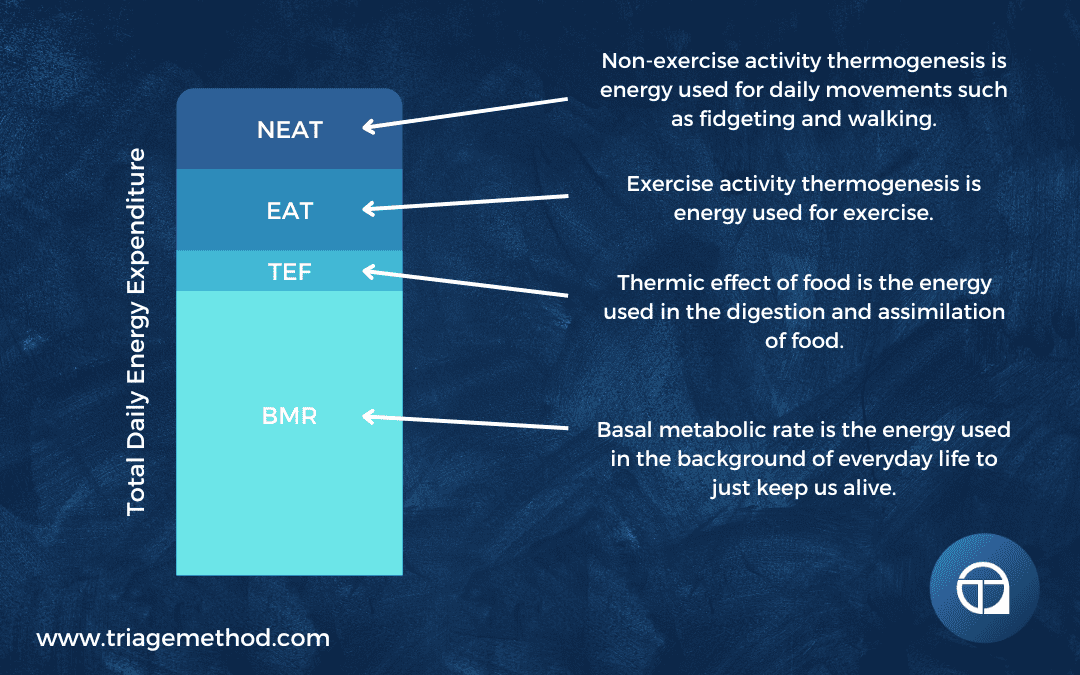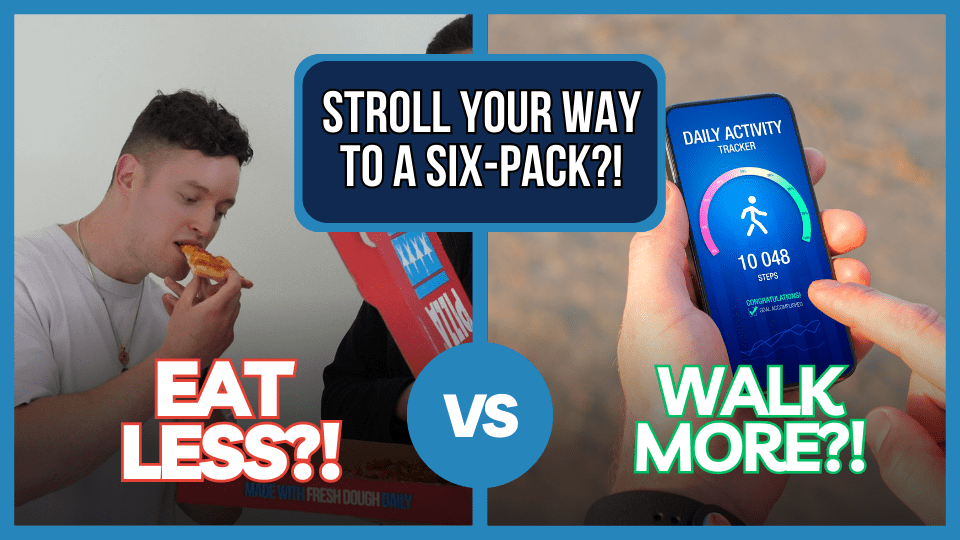Standardising your NEAT is incredibly important, yet many people don’t actually do it. NEAT is your Non-Exercise Activity Thermogenesis, the component of your metabolism that accounts for all the little movements you do throughout the day.
All of the non-exercise movements that you do throughout the day do actually add up to a significant calorie burn. So if you are fidgeting around while you read this, maybe moving your hands or feet, this is all NEAT. There is also movement occurring when you go for a walk, climb a flight of stairs, and do various different things throughout your day.
All this NEAT is, unfortunately, something that a lot of people do not factor into their overall caloric demands or overall caloric output, and thus they don’t factor it into their diet overall. This has some pretty profound effects and implications, particularly in the realm of fat loss, and we see this all the time when someone signs up for our coaching services. If you are trying to set up your diet correctly, and you don’t account for NEAT, and have a plan for standardising NEAT, you are missing out on some core components of your overall diet set-up.
Standardising NEAT To Enhance Your Body Composition And Health
When it comes to fat loss, most people focus almost exclusively on diet and structured exercise, counting calories, tracking macros, hitting the gym, and following well-planned workout routines. While these are undoubtedly crucial components of a successful body composition strategy, the role of NEAT is often overlooked.
Understanding and standardising NEAT can significantly impact your fat loss and overall health outcomes. So, let’s dig a little bit deeper into this.
What is NEAT and Why Does it Matter?
NEAT refers to the calories burned from all non-exercise activities in your daily life, things like walking, fidgeting, standing, household chores, playing with your pet, or even maintaining posture.
Unlike structured exercise, NEAT is highly variable and largely subconscious. Some people naturally move more throughout the day, while others are more sedentary without even realising it. NEAT includes everything from pacing while talking on the phone, taking frequent trips to the kitchen, gesturing while speaking, or even bouncing your leg while sitting at your desk. Essentially, it encompasses all the little movements that contribute to energy expenditure outside of structured exercise sessions.
NEAT is crucial to account for, because it can account for a significant portion of your total daily energy expenditure (TDEE). For many individuals, NEAT can make up anywhere from 15% to 50% of total calories burned, depending on lifestyle, occupation, and daily habits.

Unlike structured exercise, which typically lasts an hour or so, NEAT is happening all day long, making it one of the most powerful tools for influencing body composition. Even minor shifts in NEAT, like standing for an extra hour, opting to walk instead of driving, or taking the stairs instead of an elevator, can all accumulate into a meaningful increase in calorie burn over time. This is why two people of similar weight and height can have vastly different daily caloric expenditures simply due to differences in movement patterns throughout the day.
For example, a person with a physically active job such as a construction worker or a nurse will naturally have much higher NEAT than someone with a sedentary desk job. Similarly, individuals who frequently walk, take the stairs, or fidget often will generally burn more calories throughout the day than those who remain stationary for long periods.
Now, the issue with this is that when you diet to lose fat, your body actively tries to conserve energy by downregulating NEAT. This phenomenon is part of your body’s natural survival mechanism. It accomplishes this by subtly reducing spontaneous movement, making you more prone to sit, reducing subconscious gestures, and even altering posture to use less energy. You may notice that you fidget less, feel less inclined to take walks, or subconsciously avoid unnecessary movement.
Over time, this reduction in movement can create a metabolic adaptation that slows fat loss progress. If you aren’t aware of this and don’t take steps to counteract it, your fat loss can stall or slow significantly, leading to frustration and the misconception that your metabolism is “broken.” However, by intentionally monitoring and maintaining NEAT, you can prevent this adaptation from significantly impacting your results.
Why NEAT Decreases During Fat Loss
Your body is incredibly adaptive and resistant to losing fat. Evolution has designed us to be highly efficient at storing energy and preventing unnecessary energy loss, something that was crucial for survival in times of food scarcity. This efficiency meant that during periods of famine, humans could endure longer without food, preserving vital energy for essential bodily functions like brain activity, organ function, and immune responses.
When you create a calorie deficit through dieting, your body perceives this as a potential threat to energy stores, triggering a series of metabolic adaptations to conserve energy. One of the primary ways it does this is by downregulating NEAT. Your body essentially “defends” against weight loss by unconsciously limiting movements, reducing non-essential physical activity, and even altering hormonal signals to encourage lower energy expenditure.
This is all natural and not something to worry about, but it can make dieting for fat loss harder.
For example, if you begin a diet with a daily 500 calorie deficit, your body may respond by unconsciously minimising NEAT (this means you might fidget less, make fewer hand gestures, take fewer steps, or prefer sitting to standing). Over time, this subtle reduction in movement can significantly decrease the total calories you burn daily, making fat loss slower or even halting it altogether if not accounted for. What started out as a 500 calorie deficit, may now only be a 100 calorie deficit.
You can see this in the extreme with bodybuilders who have to diet to extremely low levels of body fat. This energy conservation can extend to subconscious habits like blinking less, speaking with less enthusiasm, and even modifying the way you breathe to expend fewer calories. Anyone who has friends who are bodybuilders will attest to the fact that they basically do not move in the last few weeks leading up to the competition.
This conservation mechanism was crucial for human survival in the past when food was scarce, as it allowed individuals to last longer on limited energy reserves. However, in the modern world, where food is readily accessible, and our goal is often to reduce body fat rather than store it, this adaptation really works against us. It can lead to frustrating plateaus in fat loss, making it feel as though your diet isn’t working despite your best efforts.
The good news is that by understanding this process, we can take proactive steps to mitigate its effects. By consciously monitoring and increasing NEAT (such as by tracking steps, ensuring regular movement breaks, and incorporating small physical habits into daily routines) we can counteract the body’s natural resistance to fat loss and maintain steady progress toward our goals.
How to Maintain NEAT for Consistent Fat Loss
While you can’t control every aspect of NEAT, you can track and regulate some components of it, most notably, your daily step count. Using step count as a proxy for NEAT allows you to maintain a baseline level of activity and ensure that your calorie expenditure doesn’t drop too drastically.
But do remember, NEAT is not just about steps, it also includes standing more, performing daily activities like cleaning or gardening, and breaking up long periods of sitting.
Step 1: Establish a Baseline
Before making any dietary changes, start by tracking your current NEAT levels. The easiest way to do this is by monitoring your daily step count.
- Use a smartwatch, fitness tracker, or a smartphone app to get an estimate of how many steps you currently take per day.
- If you don’t have access to these tools, a simple pedometer works just as well.
- Track your steps for at least a week to establish a baseline before making any adjustments.
- Additionally, try to note your overall daily movement patterns, such as how long you stand, how frequently you take breaks from sitting, and how much general activity you perform. This can help you to identify large periods of time where you are sedentary.
- If you really want to take this to psycho levels of tracking, you can consider tracking other non-exercise movements such as pacing, stretching, fidgeting, and standing duration throughout the day. These micro-movements do all contribute to total calorie burn. However, you don’t actually need to go to this level to actually stay on top of standardising NEAT.
Once you have established your baseline, you can move on to step 2.
Step 2: Standardise Your NEAT Before Adjusting Calories
Before cutting calories, it’s best to first establish consistency in your daily activity levels. If your baseline step count is around 5,000 per day, aim to maintain that number every day. Consistency is key here, fluctuating between 2,000 steps one day and 8,000 the next will make it difficult to track your true calorie expenditure. Weekly targets can work for steps, but it is generally best to have a roughly even spread of things.
It is equally important to ensure you are breaking up long periods of inactivity, such as setting a reminder to stand up every 30 minutes or opting to walk instead of taking short car rides.
- Make movement a habitual part of your daily life by integrating activity into daily tasks, such as walking while on calls, parking farther away, or pacing while brainstorming ideas.
- Use a standing desk or work in intervals where you alternate between sitting and standing.
- Set reminders to take short, frequent breaks that encourage movement, such as a quick lap around your office, house, or block.
Once you’ve successfully maintained your step count for a week or two, you can begin making dietary changes to facilitate fat loss.
Step 3: Adjust NEAT to Promote Fat Loss
Rather than immediately slashing calories, another strategy is to increase your step count to create a larger calorie deficit through movement.
- If your baseline step count is 5,000, gradually increase it to 7,500 or 10,000 per day. A higher step count ensures that you continue burning more calories throughout the day without relying solely on reducing food intake. However, there is an upper limit and going beyond ~15,000 steps per day can be impractical and unsustainable unless you have a highly active job.
- Beyond steps, try to incorporate more activity into your daily routine, such as choosing to stand instead of sitting, walking during phone calls, taking the stairs instead of the elevator, or doing small household chores more frequently.
Now, it would be rare for someone to be able to significantly alter their body composition by simply increasing their NEAT (unless they were doing very, very little to start with). So you will likely have to adjust your calories to put you in a deficit. But by standardising NEAT to this higher level, you will make fat loss much easier.
Step 4: Account for Bodyweight Changes
Be aware that even if you maintain the same step count throughout your diet, the energy cost of movement will decrease as you lose weight. A 100kg individual walking 10,000 steps will burn more calories than an 80kg individual walking the same distance.
To compensate for this, you can gradually increase step count as you lose weight. However, for most people, they will just have to eat fewer calories to keep fat loss progressing. It is just something you have to be aware of, and the more important thing is to just ensure you do standardise NEAT and don’t let your step count fall as you start getting into the depths of your diet.
Standardising NEAT Can Be A Real Game-Changer
Standardising NEAT really is one of the most effective yet underutilised strategies for improving body composition, sustaining fat loss, and enhancing overall health. By understanding and controlling NEAT, you can create a powerful tool for sustainable fat loss and long-term success.
NEAT is particularly powerful because it does not require structured time for workouts or special gym equipment. Instead, it revolves around lifestyle habits and daily movement patterns, which means it is accessible to virtually everyone. Whether you have a sedentary office job or a physically demanding occupation, there are always opportunities to maximise NEAT. The key is to recognise and take advantage of these opportunities.
By consciously maintaining NEAT, you can offset metabolic adaptation and make fat loss more predictable (and easier). Here’s why this approach works so well:
- Prevents plateaus: Keeping NEAT consistent ensures that your calorie deficit remains intact, reducing the likelihood of weight loss slowing down unexpectedly.
- Allows for dietary flexibility: Increasing movement gives you the option to burn more calories without having to cut food intake as aggressively, making dieting easier.
- Supports long-term adherence: Tracking steps is simple, requires minimal effort, and integrates seamlessly into daily life, unlike extreme calorie restriction or excessive cardio.
- Improves overall health: NEAT isn’t just beneficial for fat loss; it also enhances cardiovascular health, insulin sensitivity, and metabolic function.
Health Benefits Beyond Fat Loss
While NEAT is a game-changer for fat loss, its benefits extend far beyond weight management. Research has shown that individuals with higher NEAT levels have improved cardiovascular health, better insulin sensitivity, reduced risk of metabolic syndrome, and lower inflammation markers. Prolonged sedentary behaviour, on the other hand, is linked to an increased risk of obesity, type 2 diabetes, cardiovascular diseases, and even premature mortality.
By prioritising movement throughout the day, you can enhance circulation, support better glucose regulation, and reduce the health risks associated with prolonged sitting. Even small efforts, like standing while working, taking short walking breaks, or opting for stairs over elevators, contribute to improved metabolic health and longevity.
In addition to metabolic health, increased NEAT has been associated with mental well-being. Movement stimulates the release of endorphins, which can improve mood and reduce stress. Many individuals report higher energy levels and better focus when they prioritise movement throughout the day. Incorporating more NEAT can also improve sleep quality by promoting a natural circadian rhythm and reducing stress-related disruptions to sleep.
Why NEAT is More Sustainable Than Traditional Exercise Alone
One of the greatest advantages of NEAT is its sustainability. Many individuals struggle to adhere to intense workout routines long-term, but maintaining higher NEAT levels requires minimal effort. By making NEAT a priority, you create an environment where your body naturally burns more calories throughout the day without relying solely on structured exercise.
Structured exercise, such as lifting weights or doing cardio at the gym, requires deliberate effort, time, and sometimes even financial investment. While exercise is essential for building strength, improving cardiovascular fitness, and overall health, it typically only accounts for a small fraction of daily energy expenditure. NEAT, on the other hand, is cumulative and occurs throughout the entire day. This makes it more practical and sustainable in the long run.
Furthermore, individuals who struggle with motivation for formal exercise programs can benefit significantly from focusing on NEAT. Small changes, such as walking more, standing instead of sitting, and performing more physical tasks, require little motivation compared to committing to a structured workout program. This makes NEAT an excellent approach for those looking for a realistic, achievable way to improve their health and body composition without overwhelming lifestyle changes.
By standardising NEAT and making small, intentional adjustments to daily activity levels, you can optimise fat loss, maintain your weight loss, and improve long-term health. Rather than relying solely on calorie restriction or gym workouts, integrating NEAT into your lifestyle ensures a more balanced, flexible, and effective approach to body composition management and overall well-being.
Final Thoughts On Standardising NEAT
NEAT is one of the most underrated yet powerful factors influencing fat loss and energy balance. While traditional exercise is important, it’s what you do outside the gym that often makes the biggest difference.
Rather than focusing solely on cutting calories or increasing workouts, prioritising daily movement can make fat loss easier, more sustainable, and far less frustrating.
So if you’re serious about losing fat and keeping it off, start paying attention to your NEAT. Track your steps, stay consistent, and keep moving, I guarantee you will be surprised at just how much of an impact it makes.
If you need help with your own nutrition, you can always reach out to us and get online coaching, or alternatively, you can interact with our free content.
If you want more free information on nutrition, you can follow us on Instagram, YouTube or listen to the podcast, where we discuss all the little intricacies of exercise and nutrition. You can always stay up to date with our latest content by subscribing to our newsletter.
Finally, if you want to learn how to coach nutrition, then consider our Nutrition Coach Certification course, and if you want to learn to get better at exercise program design, then consider our course on exercise program design. We do have other courses available too. If you don’t understand something, or you just need clarification, you can always reach out to us on Instagram or via email.

